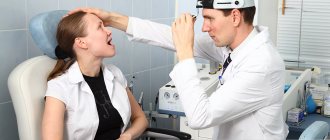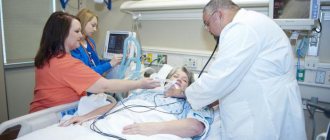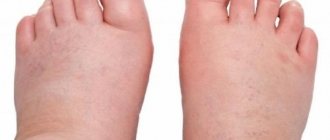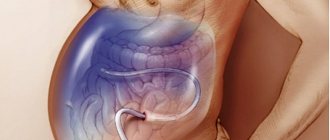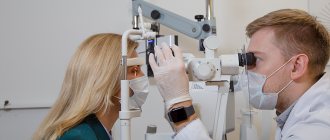Quincke's edema (or angioedema) is an allergic disease in which sudden swelling of the subcutaneous tissues and mucous membranes occurs.
Most often, Quincke's edema affects the face, mouth, respiratory tract and gastrointestinal tract. But it can also affect joints and internal organs. Damage to the larynx (due to the risk of difficulty breathing) and the brain (can lead to serious neurological disorders) is considered especially dangerous. Pathology of this type can develop in almost any person, since there are many predisposing factors: from food allergies to acute infectious diseases.
In half of the cases it accompanies urticaria, and in 11% of cases it develops in isolation. Sometimes the cause of sudden swelling cannot be found, and then it is called idiopathic. It is noteworthy that Quincke's edema is a kind of family disease, and is often transmitted, for example, from parents to children. “Inherited” a person receives a deficiency of certain enzymes that should fight substances responsible for edema.
Edema can develop, pass or recur1.
What is angioedema?
Angioedema, or Quincke's edema, is not a disease.
This is an acute allergic reaction that occurs as a result of contact of the body with an allergen and is accompanied by swelling of the skin, subcutaneous tissue and mucous membranes. According to statistics, from 10 to 20% of the world's population have experienced angioedema at least once in their lives [1].
After contact with an allergen, specialized molecules are released in the blood - inflammatory mediators. They act on the walls of blood vessels, increasing their permeability. As a result, vascular fluid penetrates into the subcutaneous fatty tissue and mucous membranes, causing their swelling.
First aid at home for Quincke's edema
Quincke's edema (angioedema) is a sudden local swelling of tissue. Appears more often on the face (lips, tongue, mucous membrane of the mouth and/or throat, eyelids) or on the hands. Treatment of an allergic reaction such as Quincke's edema should be carried out as part of emergency care, since the disease develops rapidly, within a few minutes. In severe cases, airway stridor (noisy wheezing caused by laryngeal or tracheal obstruction) occurs, a condition requiring tracheal intubation.
Causes of Quincke's edema
The main mechanism for the development of angioedema is allergic. In this case, a pathological reaction can be caused [3]:
- food products (highly allergenic foods such as eggs, whole milk, citrus fruits, nuts, chocolate, etc.);
- animal hair;
- plant pollen;
- insect bites;
- exposure to water, sunlight or cold temperatures (in susceptible individuals);
- medications (Fig. 1).
Figure 1. The most common human allergens.
Source: inspiring / freepik.com The cause may also be a genetic predisposition (hereditary form of angioedema), autoimmune diseases, previous infectious diseases, as well as medications that cause angioedema as a side effect (for example, ACE inhibitors - angiotensin-converting enzyme inhibitors used in the treatment of arterial hypertension). hypertension)[1].
In some cases, the cause remains unclear.
Who is at risk for developing angioedema?
First of all, Quincke's edema threatens those who:
- suffers from any form of allergies;
- have already encountered angioedema before;
- has close relatives (parents, brothers, sisters) who have experienced severe allergic reactions;
- takes medications that can cause edema through a non-immune mechanism (ACE inhibitors, non-steroidal anti-inflammatory drugs and some others).
People at risk are advised to carry antihistamines with them to relieve an acute allergic reaction and understand the algorithm of actions in a stressful situation.
1.What is urticaria and its causes?
In hives, light red, swollen blisters
. Usually, hives are the result of an allergic reaction, but sometimes hives appear for other reasons. The name urticaria, or nettle fever, appeared because the blisters look very similar to burns from the most common nettle.
Hives usually cause itching
, but sometimes it is accompanied by
a burning sensation on the skin
. Rashes and blisters can appear on any part of the body, even on the face, lips, tongue, throat or ears. The affected area of skin can be any size - from a few millimeters to the size of an ordinary plate. Redness and swelling with urticaria go away over varying periods of time - from several hours to several weeks.
There is another condition somewhat similar to urticaria - Quincke's edema
. But in this case, the tumor begins under the skin, and not on its surface. With angioedema, deep swelling begins around the eyes and lips, and sometimes the genitals, arms and legs. Typically, angioedema resolves in less than 24 hours. In very rare cases, angioedema in the throat, tongue, or lungs can block the airway and cause breathing problems. And then it becomes life-threatening.
Why do urticaria and Quincke's edema appear?
Urticaria and angioedema develop when blood plasma leaks from small blood vessels in the skin in response to histamine production. Histamine is a chemical that is released from special cells located in these vessels. The production of histamine can be caused by a variety of factors - allergies, chemicals from food, exposure to sunlight, medications, insect bites. There are quite a few factors for the appearance of urticaria, and therefore it is not always possible to accurately determine its cause.
A must read! Help with treatment and hospitalization!
Classification: variants of angioedema
Despite the fact that angioedema always looks the same externally, there are several types depending on the cause that caused the swelling.
Allergic
This is a variant of Quincke's edema of an allergic nature - similar to other allergic reactions: dermatitis, urticaria, etc. After the body interacts with an allergen (it can be food products, pollen, animal fur), a cascade of pathological reactions is launched. Special protective proteins, immunoglobulins E (IgE), combining with antigen, affect mast cells and basophils and lead to the disintegration of their granules. Substances contained in the internal granules of basophils and mast cells (histamine, bradykinin, etc.) cause vasodilation, an increase in their permeability, swelling and itching.
Pseudo-allergic
This option includes several forms. They are not acute allergic reactions - IgE is not involved in the occurrence of edema.
Drug
In this case, the drug itself causes mast cell degranulation. This applies to such groups of drugs as angiotensin-converting enzyme inhibitors (ACEIs - they are often used in the treatment of hypertension), non-steroidal anti-inflammatory drugs, or NSAIDs, statins and some others. The range of uses of NSAIDs is wide - from pain relief to fever reduction.
Taking these medications does not mean at all that you will develop Quincke's edema. This is a pathological reaction that occurs extremely rarely. For example, among patients taking ACE inhibitors? only 1-5% are at risk for edema. For other drugs this figure is even lower[1].
Hereditary and acquired
These forms are characterized by disruption of the immune system. It can be either congenital or acquired (autoimmune diseases, various infections). As a result, angioedema can occur as a reaction to stress, exercise, or as a result of pregnancy. An imbalance of immune system factors leads to the fact that a pathological reaction develops in a situation that does not cause any disturbances in a healthy person.
Precursors of hereditary angioedema
Exactly when such swelling will develop can be difficult to predict. However, many patients report early signs of a negative immune reaction, which can appear several hours or even a day before the swelling. Among them:
- Fatigue.
- Weakness.
- Irritability.
- Nausea.
- The appearance of a pink rash, sometimes in the form of rings.
Idiopathic
In medicine, the term idiopathic means “independent of other lesions, of unknown cause.” For this form of Quincke's edema, it is impossible to determine the cause.
Flow forms
In addition to the forms that describe the origin of the edema, options can be distinguished depending on the duration:
- acute form - the duration of symptoms does not exceed 6 weeks;
- chronic form - symptoms persist for more than 6 weeks.
You can also describe different types of angioedema depending on the affected area.
Let's look deeper...
Why does swelling occur?
The human body contains a special substance - histamine. Normally, it is found in cells called mast cells. They are found in connective tissue, lymph nodes, spleen and bone marrow and do not show themselves for the time being. As soon as a focus of inflammation occurs in the body, mast cells receive a signal from other cells, become activated and release “charges” of histamine and other substances into the blood. Histamine causes expansion of capillaries and increases the permeability of their walls. This leads to swelling in the lesion, blood flow increases and slows down, which means more and more protective cells (neutrophils and lymphocytes) are concentrated. They will help the body cope with inflammation.
The same thing happens with Quincke's edema (only there is no focus of inflammation itself, and completely other factors, sometimes quite harmless, provoke the release of histamine). And here mast cells release histamine, which causes expansion of the capillaries, increases the permeability of their walls, which leads to tissue swelling. With Quincke's edema, the process involves the deep layers of the skin and subcutaneous tissue. Urticaria is the same as Quincke's edema according to the mechanism of development, only the upper layers of the skin are involved in the process. At the same time, at the site of histamine action, blood vessels dilate, connective fibers swell and small accumulations of inflammatory cells (mainly neutrophils and lymphocytes) appear.
Quincke's edema can occur as a result of three mechanisms: allergic, non-allergic and mixed.
- With an allergic mechanism (which is extremely rare for children under 3 years of age), the child first enters the allergen for the first time (in the form of a drug, food product, pollen or insect venom). The body takes it for an enemy agent (antigen) and produces an entire army of immunoglobulins (IgE antibodies) against it. Those, like guards, are attached to the membrane (shell) of mast cells like a palisade. These antibodies have a good and, most importantly, specific memory: they clearly remember what their antigen looks like. If the allergen arrives a second time, it binds to the IgE antibody on the surface of the mast cell, which leads to its destruction with the release of histamine. That is, Quincke's edema (like any other allergic reaction) develops when the antigen is repeatedly exposed.
- In a non-allergic reaction (which occurs much more often in children), histamine is released when some factor (insect venom, medicine, food coloring, etc.) directly affects the mast cell wall.
- Hereditary angioedema (Quincke's disease) is classified as mixed forms. There are invisible soldiers in the blood (complement system from the Latin complementum - addition), of which there are about 20 (01, 02, etc.). If a foreign agent enters the blood, they begin to actively influence each other. To make it easy to imagine: when meeting with a “stranger,” the first 01 wakes up and pushes the second 02; he bothers the third 03 (the third is sometimes activated without the first two); the third - the fourth, and so on - until a “heap of small things” is formed, which with its power breaks through the cell wall. In fact, these are, of course, not soldiers, but proteins that are in an inactive state. They would be happy to constantly activate and destroy cells (not only foreign ones, but also their own), but they are hampered by their bosses (inhibitor proteins), who constantly suppress their activity.
Problems with a genetic breakdown arise when there is little (from 5 to 30% of the norm) in the blood of those most formidable bosses - protein 01 or 03 inhibitor. Protein 01 in this case is happy to try: it “blows the whistle” for any unnecessary reason. A child cuts himself, gets nervous, becomes hypothermic, undergoes surgery - complement is activated and Quincke's edema occurs, and often the most unfavorable option is with swelling of the larynx, less often - of the gastrointestinal tract or meninges. When interviewed, it turns out that in the family from generation to generation there have been cases of laryngeal edema in relatives. This allows us to suspect the hereditary nature of the edema. Fortunately, such cases of the disease are very rare.
Symptoms of Quincke's edema
The main symptom of Quincke's edema is progressive swelling of the subcutaneous tissue of various areas.
Areas that may be affected:
- faces: forehead, eyelids, cheeks, lips, tongue, etc. (Fig. 2);
- scalp;
- neck;
- genitals;
- outer surface of feet and hands;
- arms and legs in the joint area.
Figure 2. Angioedema affecting the face, lips, tongue, arms and legs.
Source: International Journal of Emergency Medicine / Open-i (Attribution 4.0 International), Journal of pharmacology & pharmacotherapeutics / Open-i (Attribution-NonCommercial-ShareAlike 3.0 Unported), Anais brasileiros de dermatologia / Open-i (Attribution-NonCommercial 3.0 Unported ), Allergy, asthma & immunology research / Open-i (Attribution-NonCommercial 3.0 Unported), The Korean journal of internal medicine / Open-i (Attribution-NonCommercial 3.0 Unported). The skin above the surface of the edema may not be changed and be of normal color. In this case, there will be no itching. However, in 48% of cases[2], angioedema is combined with urticaria. With this option, there is itching, redness at the site of swelling, and blisters may occur.
Important! Quincke's edema tends to spread to neighboring organs and tissues. If swelling occurs on the face (eyelids, lips, tongue), special care should be taken, since the pathological process can affect the airways and cause breathing problems. If you notice sudden progressive swelling of your eyes, lips or tongue, you should immediately take an antihistamine and consult a doctor or call an ambulance.
Patients with angioedema may also be concerned about:
- spasmodic abdominal pain, nausea, vomiting - with swelling of the gastrointestinal mucosa (symptoms of such swelling can be confused with appendicitis or irritable bowel syndrome, the stomach may look bloated);
- difficulty breathing, changes in the sound of the voice, a feeling of a “lump” in the throat - with swelling of the airways.
Quincke's edema in children
External manifestations and symptoms in children do not differ from the symptoms of Quincke's edema in adults.
But some features of the child’s body (immaturity of the immune system, large specific mass of subcutaneous fat) can contribute to a more rapid spread of edema. In addition, in children much more often than in adults (in 93% of cases!), edema develops in the head area.[5] Therefore, emergency care must be provided to the child without delay to prevent breathing problems. As a rule, swelling in children is caused by an allergic reaction to a previously consumed product or medicine. However, parents often cannot name the exact cause of angioedema. Thus, many cases of angioedema in children can be avoided if you pay close attention to the child's diet, for example, keeping a food/medicine diary, especially when the child is allergic.
What forms of angioedema exist?
HAE – hereditary angioedema
HAE (hereditary angioedema) is a dominant autosomal disease. It is characterized by the irregular occurrence of angioedema in any area of the body. This complement-dependent angioedema accounts for no more than 2% of all cases.
It is very important to diagnose the disease in a timely manner using a screening test. If the values are normal, the patient does not have HAE. This happens in 96% of cases: in this case, there is no need for further diagnosis.
Angioedema can be caused by ACE inhibitors: the disease develops from the first days of use and continues to worsen over several months of regular use of the drug. Foci of Quincke's edema can appear in the area of the tongue, lips, larynx, neck, and pharynx. In some cases, intestinal edema develops, without any special external manifestations on the skin and visible mucous membranes, but accompanied by abdominal pain.
Prevention of angioedema, which is caused by ACE inhibitors, consists of complete abstinence from taking all drugs of this class. Patients need consultation with an allergist; in addition, they must always have with them a bracelet or document informing them about the disease and the specifics of treatment.
PAO – acquired angioedema
Patients may also experience acquired C1 inhibitor deficiency. In this case, the clinical picture of the disease does not include a burdened hereditary history, and the disease begins to manifest itself after 40 years. Against the background of the immunodeficiency virus, acquired complement-dependent edema of lymphoproliferative diseases, multiple myeloma, chronic hepatitis B and C can occur. PAO often appears several years before the onset of the underlying disease.
What symptoms are characteristic of Quincke's edema?
The main symptom is limited and painless swelling of the mucous skin, the membrane of subcutaneous adipose tissue, which causes a feeling of distension of the skin. The disease can occur spontaneously or under the influence of triggers - provoking factors (stress, trauma, acute viral infection, surgery, alcohol, ACE inhibitors, estrogen drugs).
Quincke's edema can begin unexpectedly. Within a few minutes, swelling appears, with sharply defined borders of a pale color. The size of the swelling can vary: from a coin to a child’s palm; it can last for several hours and then disappear without a trace.
Quincke's edema often occurs in the area of the tongue, eyelids, lips, ears, soft palate, hands, feet, and genitals. Some people (no more than 25%) experience swelling of the trachea, larynx and large bronchi: it is characterized by hoarseness, a feeling of lack of air and a “barking cough”.
The patient experiences only skin tension in the area of edema: there are no other sensations, not even itching. But when pressed, a hole does not appear. Quincke's edema can occur with typical urticaria rashes. The appearance of edema in the bladder mucosa can lead to difficulty urinating, and in the intestinal mucosa - to abdominal pain.
Swelling of the trachea, pharynx, and larynx is the most dangerous and is observed in every fourth case. Characteristic features are: sudden anxiety, aphonia, difficulty breathing, hoarseness, and in some cases even loss of consciousness. During examination of the mucous membrane of the throat, swelling of the palatine arches and soft palate can be observed, the lumen of the pharynx narrows, and there may be a threat of acute lack of air - asphyxia. In this case, emergency medical intervention is required.
How can angioedema be diagnosed?
To clarify the diagnosis, it is important to consult an allergist, and an experienced immunologist will tell you what needs to be taken so that allergy treatment is systemic. It is imperative to identify the factors that provoke the onset of the disease. For example, you need to find a connection with taking some medications, foods, etc. This connection can be further confirmed using allergic skin tests.
It is necessary to evaluate a general blood test, urine test, determine functional activity and the level of C1 inhibitor, conduct allergy tests, clarify biochemical blood parameters, levels of C4, C1q and C2 components of the complement system. In this case, it is necessary to exclude intestinal diseases, autoimmune diseases, blood diseases, and conduct stool tests for helminths.
What is needed to treat angioedema?
Treatment of the hereditary form of angioedema is impossible without medications that are prescribed to enhance the body’s production of the missing inhibitor (currently not yet registered in Russia). The main task is to identify the root cause of the disease and eliminate it.
For treatment you can use:
- attenuated androgens;
- tranexamic acid;
- fibrinolysis inhibitors;
- fresh or fresh frozen aminocaproic plasma;
- various diuretics.
If the patient is diagnosed with idiopathic angioedema (with an unknown cause), it is necessary to use modern antihistamines for a long time. The choice of one of the antihistamine non-sedative drugs will be influenced by a consultation with an allergist, at which the patient’s individual characteristics and reaction to the new generation drugs will be determined.
The use of antileukotriene drugs may be necessary. If a severe course of the disease is initially diagnosed, it is necessary to use GCS, gradually reducing the dose to the minimum effective. If after using all of the above treatment methods there are no positive results, you can perform blood plasmapheresis, treatment with cyclosporine, use hydroxychloroquine, sulfasalazine, thyroxine, warfarin, methotrexate.
How to properly prevent the disease?
If the cause of angioedema is a drug or food allergy, you will need to consult an allergist, at which the specialist will recommend avoiding foods or medications that cause swelling.
All patients with HAE need to be treated for emerging foci of chronic infections, because with their exacerbation, the development of angioedema may occur. It is also advisable to exclude the use of oral contraceptives that contain estrogens, ACE inhibitors, including plasminogen activators.
Specialists at the Gorbakov Clinic advise following a strict diet (excluding all allergens), eliminating allergens from the patient’s environment, and taking preventative antihistamines during contact with various allergens or when plants are blooming.
Experienced allergists and immunologists at the Clinic will conduct professional diagnostics and prescribe adequate treatment, after which you can quickly and safely get rid of the symptoms of the disease and return to your usual way of life.
Quincke's edema is an allergic disease that is characterized by lightning-fast development and an increase in symptoms. Angioedema can affect any part of the body, which naturally causes significant inconvenience to patients. If you have ever experienced similar symptoms, or anyone in your family has suffered from angioedema, we recommend that you immediately seek advice from an allergist-immunologist, who will select the optimal course of treatment or recommend preventive measures.
First aid for severe forms of Quincke's edema
If your face swells, you need to call an ambulance.
Photo: georgejmclittle / Depositphotos If you observe symptoms of angioedema in yourself or someone nearby for the first time, you should immediately call an ambulance. Most cases of angioedema are not life-threatening. But if you see that the swelling spreads to the head area, rapidly increases, the person begins to choke and his condition worsens, before the ambulance arrives, you should stop the patient’s contact with the allergen (if known), give the patient a semi-sitting position, unfasten the pressure clothing and ensure an influx fresh air. An antihistamine in standard dosage may also provide relief to the patient. It should be understood that the drug must have time to enter the bloodstream from the gastrointestinal tract, so you should not expect an immediate effect [4].
When to call an ambulance for Quincke's edema
Kovalchuk Maria Sergeevna, emergency doctor:
“This is angioedema, often of an allergic type. It differs from inflammatory edema by the absence of local hyperthermia and hyperemia, i.e., not red and not hot. Quincke's edema often occurs on the lips, cheeks, eyes, and mouth. Treated with conventional antiallergic drugs. The danger is swelling of the larynx. If a person with Quincke's edema begins to breathe noisily or heavily, he has a feeling of lack of air, a barking cough appears, a hoarse voice appears, and visually when examining the oral cavity, swelling of the arches, tonsils or soft palate with the tongue is visible, then in this case you need to urgently call an ambulance or go to the nearest hospital.”
Symptoms of angioallergic edema
Symptoms of Quincke's edema
usually appear unexpectedly, spontaneously and develop quickly (10-20 minutes), less often a delayed reaction is observed - up to 2-3 hours. After treatment it does not leave marks, but may return. Depending on the reason, these could be:
- progressively increasing itching in the mouth and larynx;
- very quickly “spreading” swelling: usually symptoms of Quincke’s edema are present on the cheeks, lower and upper lips, eyelids, and the outside of the hands;
- Nausea (including vomiting) may occur;
- Difficulty intermittent breathing, suffocation, dry barking cough, sometimes painless or accompanied by wheezing, cannot be excluded.
How can pathology develop?
The essence of the pathology with symptoms of Quincke's edema
:
- the immune system reacts to substances (drugs, products) that enter the body;
- in response to cells that the defense system perceives as foreign, a local or local reaction occurs - the subcutaneous fatty layers of tissue and mucous membranes swell;
- swelling - the most dangerous symptom of Quincke's edema - can spread to different areas or be localized in one place (face, limbs, groin area);
- swelling is accompanied by an expansion of the lumen of the blood vessels, their walls are weakened, “stretched”, the entire circulatory system can react with further spread of swelling.
The most serious symptoms of angioedema are associated with swelling of the face (lips, cheeks, eyelids) for two reasons. Firstly, there is a high risk of spread to the respiratory tract (swelling of the larynx, narrowing of the pharynx). Secondly, the threat of swelling in the brain tissue increases.
Types, development, important nuances of angioedema
Depending on the provocateur of Quincke's edema and the symptoms, the disease is divided into two types - allergic and pseudo-allergic. With allergies, the problem is the entry of irritant allergens into the body. This:
- various foods from the diet (nuts, citrus fruits, strawberries, chocolate, eggs, dairy products);
- household factors (dust, household chemicals);
- symptoms of Quincke's edema accompany hay fever, bronchial asthma and other diseases of this group.
In the case of the pseudo-allergic nature of Quincke's edema, diagnosis of the disease is complicated by the fact that the disease itself is caused by pathologies of the complement system. The latter do not manifest themselves until a certain age or event. In such patients, symptoms of Quincke's edema can appear at any age under a variety of circumstances - stress, hormonal surge, changes in temperature (environment, body).
When is it necessary to see a doctor?
You need to see a doctor:
- if Quincke's edema occurred for the first time;
- if the area of the face, neck, scalp is affected;
- if the swelling spreads to several parts of the body;
- if there are signs of swelling of the internal organs (difficulty breathing and changes in voice timbre, abdominal pain, bladder spasms, etc.).
In the case of a mild form of an allergic reaction that does not have a large area and does not worsen the general condition of the patient (for example, a local reaction to an insect bite), it is permissible to take an antihistamine and observe the site of swelling. Applying ice and cold compresses have a good effect. Mild forms often go away on their own within 1-2 days and do not cause complications.
Diagnostics
Quincke's edema is easily diagnosed by the presence of external signs. It is much more difficult to determine the real cause of its occurrence. Unfortunately, there is no single test to identify the cause of swelling. However, there are a number of examinations that will help more accurately determine the form of edema and make a diagnosis.
1. Allergy diagnostics.
A set of studies is carried out in order to establish or exclude a connection between the resulting angioedema and any allergen. The first stage includes a conversation with the patient and his relatives in order to find out whether similar reactions have already occurred before, whether there is a connection with taking any product or medicine, with contact with animal fur. You also need to find out whether relatives or the patient himself previously had other allergic conditions (bronchial asthma, urticaria, allergic dermatitis, etc.), as well as atopic dermatitis in childhood. People who have experienced the allergic variant of angioedema are most often predisposed to allergies and have almost always previously experienced some kind of allergic symptoms.
If the patient is suspected of having an allergic variant of angioedema, skin allergy tests and laboratory blood tests are performed:
- Skin allergy tests. Using special lancets containing a small amount of suspected allergens, the skin is slightly scratched on the inside of the forearm. Next, the skin reaction to the allergen is assessed (Fig. 4).
- Laboratory research. Specific indicators are determined in a patient's blood sample to understand whether there was an allergic reaction of the immune system to the suspected allergen.
Figure 3. Skin allergy tests.
Source: lev.studio.x / freepik.com 2. Other laboratory tests: if hereditary or acquired variants of pseudoallergic angioedema are suspected, the doctor prescribes blood tests to determine the level of proteins of the complement system and other indicators to confirm or refute the diagnosis.
The idiopathic variant is a “diagnosis of exclusion”, which is made when other, more likely diagnoses are not confirmed.
Treatment of Quincke's edema
The main treatment for angioedema is medication. After first aid has been provided to the patient, the doctor prescribes medications to the patient. If the condition does not require emergency intervention, the patient can take pills. If swelling rapidly increases and causes breathing problems, a medical professional performs intramuscular or intravenous injections.
The two main groups of medications used are antihistamines and glucocorticosteroids.
Antihistamines
They block the effects of histamine, which means they constrict blood vessels and reduce swelling.
Several generations of drugs are used: hifenadine, clemastine, chloropyramine, loratadine, cetirizine and others. Antihistamines are prescribed not only in the acute period; the doctor may recommend taking a course of the drug for 7-14 days.
Important! First generation antihistamines (diphenhydramine, clemastine, chloropyramine, promethazine, etc.) may cause drowsiness as a side effect in some patients. Therefore, if you are taking a drug from this group and notice drowsiness or weakness, you should temporarily limit driving, activities that require high concentration, and drinking alcohol. At the end of the course, restrictions can be removed.
Glucocorticosteroids
These are hormonal drugs that affect many parts of the immune system. Their action is faster, more powerful, and in combination with antihistamines, they quickly eliminate the symptoms of angioedema. The most commonly used is prednisolone. It is prescribed both in the acute period and after a case of edema in a course of 3-5 days.
Other drugs
The following are also used as symptomatic treatment to alleviate the symptoms of angioedema:
- adrenaline injections - if there is a threat of laryngeal edema;
- diuretics (furosemide) - help reduce swelling;
- enzyme preparations, sorbents.
To treat hereditary and acquired forms of angioedema, which are associated with a violation of the complement system, specific drugs are used that affect this part of the immune system: danazol, tranexamic acid, etc.
Causes of angioedema in adults
The cause of angioedema is exposure to an allergen (for example, peanuts, chocolate). However, either idiopathic edema of unknown etiology or poorly correlated with allergen exposure is common. Angioedema may reflect some kind of somatic pathology: diseases of the gastrointestinal tract, dysfunction of the endocrine system, chronic foci of infection, parasitic infestations, systemic diseases.
The cause of angioedema in adults can be chemicals, including medications, and physical factors (temperature, pressure). Quincke's edema often develops under the influence of several factors at once.
The hereditary form (HAE) often remains undetected for a long time, since its symptoms may resemble those of allergies, intestinal colic or other pathological conditions. An important point is that HAE is not relieved by antihistamines and glucocorticosteroids. How to treat hereditary angioedema? Therapy for HAE is fundamentally different from therapy for angioedema. In the acute period, hereditary angioedema is relieved by the administration of fresh or fresh frozen native plasma, intravenous administration of tranexamic or aminocaproic acid, danazol, Lasix.
Complications
If the condition is not stopped at the first signs of edema, this can lead to the development of severe complications:
- breathing problems - due to sudden or progressive swelling of the respiratory organs;
- dizziness and fainting;
- collapse is a condition close to fainting, which is accompanied by a sharp drop in blood pressure and a rapid deterioration in the functioning of important body systems.
Complications of angioedema can be avoided with timely medical care. After relief of long-term effects of edema, no swelling is observed.
Prevention
Preventive measures are especially relevant for people with a predisposition to allergies and those who have already had angioedema. Such measures include:
- following a strict diet;
- avoiding contact with allergens, in particular with food products that often cause allergic reactions (Fig. 4);
- preventive use of antihistamines during the flowering period of trees.
Figure 4. Foods that often cause allergies. Source: cgon.rospotrebnadzor.ru, who.int, toitumine.ee, fda.gov
Did you have Quincke's edema? Carry your medicine with you!
If angioedema has already happened to you before and was severe (with swelling of the face, breathing problems, possibly loss of consciousness), it is recommended to have a dose of an antihistamine and hormonal drug with you. Check with your doctor for the specific drug and its dosage. If you feel the beginning of swelling, you can stop its spread in the initial stages. Also, carry a small card with you that tells you that you are prone to angioedema and list the allergen if you know one. This will help people providing first aid quickly make a diagnosis and carry out the necessary manipulations.
3.Diagnosis of the disease
The diagnosis of urticaria or Quincke's edema is made after examination. Your doctor will ask you a few questions to find out the possible cause of your hives or angioedema and examine your skin. Depending on your health condition, you may need to consult an allergist, immunologist or dermatologist.
Skin tests may be done to determine which substance is causing your allergy. And routine blood tests are needed to determine the presence of some systemic disease.
About our clinic Chistye Prudy metro station Medintercom page!
Sources
- Angioedema symptoms & treatments - Illnesses & conditions [Electronic resource] // NHS inform.
- O. B. Pavlov, D. E. Bychkovsky, A. A. Poprotskaya, E. M. Suschaya. Quincke's edema [Electronic resource] // Educational Institution "BSMU", Institution "3rd City Clinical Hospital named after. E.V. Klumova.”
- Stuart I. Henochowicz, David Zieve, Brenda Conaway. Angioedema [Electronic resource] // medlineplus.gov, 2021.
- Angioedema [Electronic resource] // Wikipedia.
- S.I. Bardenikova, S.Yu. Snitko, O.B. Dovgun et al. Features of the clinical picture and course of acute allergic reactions (urticaria and Quincke's edema) in children // RMZh. 2019;1(II):71-76.
4.How to treat urticaria and Quincke's edema?
The easiest way to deal with urticaria and angioedema is if you can identify and eliminate the factor that caused the problem. But this is not always possible. Typically, antihistamines are used to treat hives. They will help relieve the symptoms of the disease. Sometimes antihistamine medications need to be taken regularly to prevent the rash and associated swelling.
Chronic urticaria is treated with antihistamines or a combination of them. But if this does not give the desired result, sometimes the doctor prescribes corticosteroids.
In severe cases of urticaria and angioedema, an injection of adrenaline or steroid medications may be necessary.
What else can be done to treat hives?
While the course of treatment is ongoing and you are waiting for the redness and swelling to disappear, follow these simple recommendations.
- Do not use hot water. Let it just be warm.
- Wash with mild soap.
- You can apply cold compresses or apply a damp cloth to the affected areas.
- Be in a cool room.
- Wear loose, lightweight clothing.

